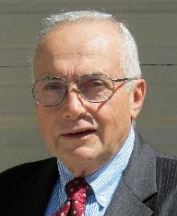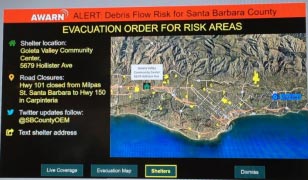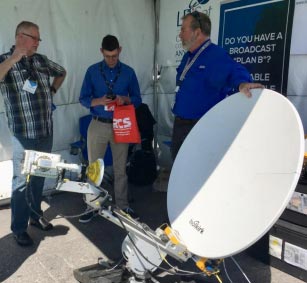A Completely Different View of NAB

[April 2019] Among the crowds at this year’s NAB Spring Show, Richard Rudman walked as fast as he could to find things of interest to those who could not get there. Let us follow in his steps:
In the classic words I have stolen from the old Monty Python Show, “Now for something completely different.” This will be a mix of personal impressions with some crossover to non-radio topics you may not have heard of yet.
Starting With the NUG
My 2019 sojourn through NAB Week began at the Nautel Users Group (NUG) meeting on Sunday.
Confabs like this are Convention highlights for many. Going back to my first NAB in 1975, my then employer, Group W, brought all their radio and TV engineering managers to NAB for meetings. Other groups did that too.
Many friendships and “workships” were started in those days. Thanks to some industry vendor mainstays and the SBE we have opportunities to both relive and contribute to this tradition. I see a common thread from years past to events like the NUG where hints, kinks, pitfalls, and fellowship are on the agenda.
Drones Away!
What did I find was different about the 2019 event?
Last year you could not walk down too many aisles without either seeing or being “near-missed” by a demonstrated drone aircraft. This year I only saw one, offered by a vendor who offers a six-arm drone as a well thought out aerial signal measurement tool. They offered a range of antennas and systems that can perform aerial signal measurements from 9 kHz to 800 MHz.
The heart of their system is a light weight spectrum analyzer with an embedded PC. I was told they will either sell you a complete system along with requisite training, or come to your market and perform measurements themselves.
Either option does not come cheap, but I know that such a properly designed drone system can 2 be as or more accurate and valuable as piloted helicopter measurements. Their brochure outlines typical uses cases that range from troubleshooting new or existing antenna systems, verification of regulatory compliance, confirmation of computer modeled predictions, and interference hunting.
EAS Matters
As the Vice Chair for the California EAS State Emergency Communications Committee (SECC) and a core member of the Broadcast Warning Working Group (BWWG), I feel dutybound to offer some comments on the state of alert and warning issues, hardware and software as of NAB/2019.
The only meeting this year for EAS Participants was organized by BWWG Core Member and Chair of the Nevada EAS SECC, Adrienne Abbott. As has been the case for the past several years, this meeting focused on ongoing discussions with the National Weather Service (NOAA/NWS and their EAS event originations on their National Weather Radio (NWR) product.

The discussion group was led by Adrienne Abbott (r)
NOAA’s Director of the Office of Dissemination Michelle Mainelli based in Silver Springs, MD attended this year along with key staff to report on developments and ideas to reconcile the overall mission of NWS/NWR to deliver weather risks to the public that are sometimes at odds with the very nature of broadcasting. EAS Participants monitor NWR VHF stations for EAS weather events.
NWS is looking at regionalization and other means to help EAS Participants with what sometimes seems like a flood of messages that are intended for areas well outside coverage areas. A pilot program for the State of Nevada was outlined that will be watched closely. This represents a very positive step toward solving problems we identified to NWS years ago.
ATSC 3 and EAS Warnings
The pending new TV standard, ATSC 3.0, brings with it opportunities for better warnings.
A number of off shore developers have their own ideas of how to best implement alerts and warnings. I am keeping my eye on AWARN, the Advanced Warning and Responsive Network initiative. AWARN is a “cross industry, international coalition formed to create the world’s most advanced emergency messaging system.”

As AWARN puts it, when it is fully deployed, ATSC 3.0 brings with it “geo-targeted, rich media alerts to an unlimited number of enabled TV’s, connected cars and handheld devices even when cellular fails or the grid goes down.” Their promised improvements are impressive, but we will have to wait for full implementation of ATSC 3.0 and the inevitable need for home, vehicle, and personal device upgrades.
Monetizing Alerts
What I observed is that not all of the warning solutions shown at NAB 2019 on the floor work the same and/or have their warning purpose overshadowed by the need to monetize.
One vendor I talked to last year seemed to me to downplay warnings in favor of ATSC 3.0’s ability to push targeted advertising to viewers.
One screen I saw had the program content in a screen box surrounded by ads. Not really what I personally want when watching movies, news, or the current season of Seth McFarland’s The Orville.
I really hope I am wrong about what could wind up as a further commercialization of televised offerings, including life safety information whose purpose is to help a public at risk deal with threats to their lives and property.
Outside Broadcasting
Outside at the displays in the windy open air that Las Vegas seems to provide during NAB events, a fleet of large and small remote broadcast vehicles was set out for our inspection.
A flock of new and some improved – realistically designed and priced fly-away satellite uplink packages – are being offered.

Such packages can be used for more than remotes anywhere, any time. They can provide for a more cost-effective solution for emergency restoration when high winds, floods, major power failures and Internet outages happen.
When looking at what is being offered, look for vendors who offer years of satellite experience, real long term 24/7 customer support, and good training programs.
Site Security
More high-quality cameras for security/surveillance seemed to be offered this year.
 I saw one $5500 PTZ (pan-tilt-zoom) camera named “sky boss” that has infrared night illumination that can reach out 100 feet and daytime HD pictures far better than we are used to see for such systems.
I saw one $5500 PTZ (pan-tilt-zoom) camera named “sky boss” that has infrared night illumination that can reach out 100 feet and daytime HD pictures far better than we are used to see for such systems.
While I think this product is intended primarily for governments and police department use, large broadcast facilities might be interested for parking lot and transmitter site supervision, and may think the hefty price is worth it.
Better security is emerging on the floor for broadcasting’s growing Internet of Things (IOT). Barix is now offering products with better Internet security, and there are now products from other vendors with the same goal in mind to hopefully thwart or at least slow down the inevitable rise in spoofing and hacking.
Incubation
The incubator section in the North Hall started in the last few years offers start-ups the benefits of floor traffic without the overhead of a full booth.
 Set up at tables and kiosks, the range and variety is definitely getting more impressive and possibly more disruptive to established Industry vendors.
Set up at tables and kiosks, the range and variety is definitely getting more impressive and possibly more disruptive to established Industry vendors.
Even more impressive has been the rise of many small woman-owned and operated enter-prises. I walked by a stage with a large banner that read 4 “INNOVATION PIPELINE THEATRE.” All the panelists on stage were women.
A Sad Note
The afterglow of the whirlwind week of NAB 2019 activities was muted for many with the news that Ron Rackley passed away just after returning to his home in Florida.
I was party to one of what I am sure were many floor, corridor and lobby discussions with Ron fans and colleagues. Ron was a teacher, mentor and much more to all in his folksy down-home way.
Typical of this when I joined one Ron-centered cluster on Wednesday were details and memories Ron himself brought up that made us all feel part of his broadcast engineering family circle.
If any RF engineer could lay claim to an RF engineering version of the medical profession’s bedside manner, it would be Ron.
While I join with the countless numbers who have expressed the sentiment that he rest in peace, knowing Ron I doubt he will in whatever afterlife he is now part of.
And Now For Something Completely Different
Now to end this report with something completely different.
This year was my first with the “Steps” app on my iPhone. From Sunday morning to Wednesday evening, the app said I took 66,641 steps for a total of 22.83 miles. Scary to see a documented reality for what we suspect happens to our feet during NAB Week!
– – –
Richard Rudman is the Vice Chair, California Emergency Alert System State Emergency Communications Committee (SECC) and a Core Member of the Broadcast Warning Working Group (BWWG). You can contact Richard at rar01@me.com
